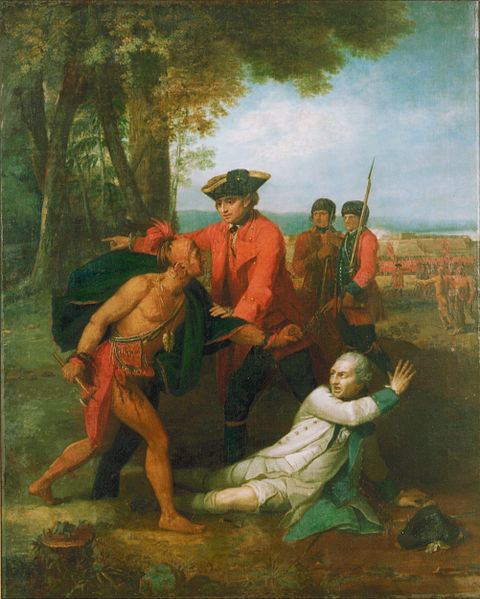<Back to Index>
- General of the French Army Jean Erdman, Baron Dieskau, 1701
- Captain of the French Colonial Troops François - Marie Le Marchand de Lignery, 1703
PAGE SPONSOR

Jean Erdman, Baron Dieskau or Jean - Armand Dieskau, Baron de Dieskau or Ludwig August von Dieskau (1701 Saxony – 8 September 1767 Surenne) was a German born soldier remembered mostly as a French general and commander in America for a part of the French and Indian War.
He was aide - de - camp of Marshal Maurice de Saxe, and visited St. Petersburg in that officer's interest in 1741. He also served in the Netherlands, and in 1748 became major general of infantry and commander of Brest. He was sent to Canada on 20 February 1755, at the head of French troops, to conduct the campaign against the British.
His forces comprised 600 Canadians, as many Indians and 200 regular French troops. He ascended Lake Champlain to its head, designing to attack Fort Edward; but the guides took the road to Lake George by mistake. On 8 September, he was informed by scouts that a detachment of 1,000 men under Col. Ephraim Williams, of Massachusetts, had been sent against him, and, disposing his men in ambush in the form of a horseshoe, he surprised the enemy and put them to flight.
After pursuing their opponents to the British camp, the Indians halted, the Canadians became alarmed, and Dieskau, with his 200 regulars, was forced to sustain the fight. For five hours the New England militia “kept up the most violent fire that had yet been known in America.” Almost all the French regulars perished, and Dieskau himself was wounded three times; but he refused to retire, and seated himself on a stump, exposed to the bullets. Finally, seeing a soldier approaching as if to capture him, Dieskau put his hand into his pocket for his watch, which he intended to give to his captor; but the man, supposing that he was drawing a pistol, shot him, inflicting a wound that ultimately caused Dieskau's death over a decade later.
This event became known as the Battle of Lake George. Dieskau was kept a prisoner until 1763, when he was exchanged and returned to France, where he was given a pension. Command in Canada passed to Louis - Joseph de Montcalm.
François - Marie Le Marchand de Lignery (24 August 1703 – 29 July 1759) was a colonial military leader in the French province of Canada. Active in the defense of New France during the Seven Years' War (also known as the French and Indian War), he died of wounds sustained in the 1759 Battle of La Belle - Famille.
Born into a military family (his father was Constant le Marchand de Lignery, an officer of the French colonial military) in Montreal, Lignery enrolled as a cadet in the troupes de la marine at 14, and first saw service in 1728 during the Fox Wars. He also saw service in the Chickasaw Wars and King George's War, where he participated in attacks on Fort Anne and Grand Pré. In 1751 he was promoted to captain.
When the French and Indian War broke out, Lignery played an important role in the French defense of the Ohio Country. He distinguished himself in the defeat of Braddock in 1755, in which his company held the French center while Indians and Canadien militia were rallied early in the battle. For his role in the battle he was awarded the Cross of Saint Louis. Given military command of the entire Ohio Country in 1756, he used Fort Duquesne as a base from which to harass British colonial positions in Virginia and Pennsylvania. In 1758 he captured much of a British force led by James Grant that attempted to take Fort Duquesne. Unfortunately, a force he sent out to counterattack the advancing troops of John Forbes was repulsed, and he decided in November 1758 to abandon and destroy Duquesne when it became clear that Forbes' force significantly outnumbered his.
Lignery retreated to Fort Machault, from which he continued to direct harassing raids against the British in 1759. He was organizing an expedition against Fort Pitt (the fort built by the British on the site of Fort Duquesne) when he received an appeal for help from Pierre Pouchot, the commander at Fort Niagara. Pouchot had sent Lignery some troops, but was himself now under siege by the British and requested assistance. Lignery, who was trying to convince nearly 1,000 Indians to join in the attack on Fort Pitt at the time, convinced 500 to join his force of 800 troupes de la marine in a relief expedition. On June 24 his force was ambushed by the British as it neared Fort Niagara. The battle was a disaster for the French, and Lignery was seriously wounded and captured. Pouchot surrendered Niagara the next day, and Lignery died of his wounds on June 28.
Lignery married Marie - Thérèse, daughter of Daniel Migeon de La Gauchetièr, on 27 January 1738. They had seven children, five of whom survived to adulthood. His sons also served in the French military, and Marie - Thérèse moved to France and received a widow's pension.